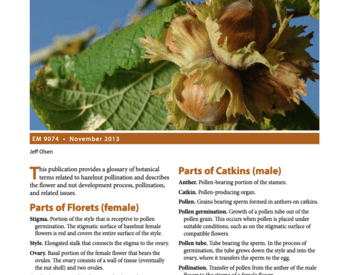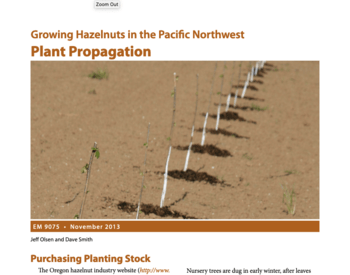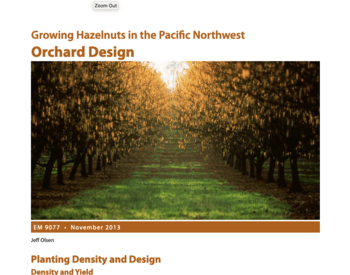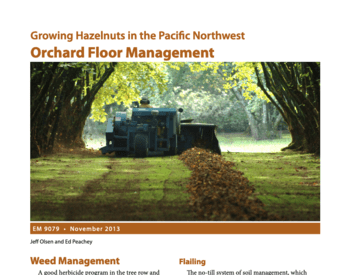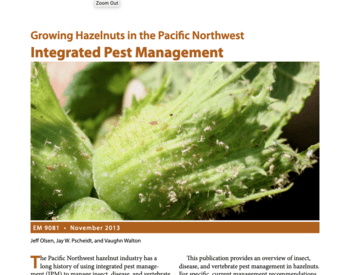Hazelnut History
Origins
Hazelnuts, sometimes called filberts, have a long and fascinating history. The name filbert probably derived from the German term vollbart (full beard) in reference to some hazelnut varieties in which the husk entirely covers the nut. However, some people believe the name derives from St. Philibert, whose feast is celebrated on August 20, about the time the earliest hazelnuts ripen in England. In the Pacific Northwest, we grow Corylus avellana, the European hazelnut. The genus name Corylus comes from the Greek word korys (helmet or hood). The word hazelnut is derived from the Anglo-Saxon word haesel (bonnet).
The European hazelnut (C. avellana) grows in many parts of Europe and Asia and has been a food source for humans since prehistoric times. From 7500–5500 BCE, the European hazelnut was one of the first shrub-like trees to spread northward after the last glacial period in northern Europe. It was the dominant form of woody vegetation in the British Isles and some parts of Scandinavia. Archeologists have studied the pollen grains of plants that were deposited in the peat layers formed in that era. The number of hazelnut pollen grains preserved in the peat was greater than the number of pollen grains for all of the other species put together.
Charred fragments of hazelnut shells were found in many Stone Age sites (8000–2700 BCE) in what is now Sweden, Denmark, and Germany. A manuscript found in China from the year 2838 BCE lists hazelnuts as one of China’s five sacred foods. Greek literature from the first century mentions that hazelnuts were brought to Greece from the shores of the Black Sea, the location of present-day Turkey.
Hazelnuts in the Pacific Northwest
One hazelnut species (C. cornuta var. californica) is native to the Pacific Northwest. However, cultivated hazelnut varieties (C. avellana) were introduced to the western United States from Europe. In 1858, Sam Strickland, an English sailor who retired from the Hudson’s Bay Company, planted the first hazelnut tree in the Pacific Northwest in Scottsburg, Oregon.
The speculation is that these first hazelnut trees planted in Scottsburg probably came from one of the Luelling nurseries near present-day Albany, Oregon. Pioneer nurseryman Henderson Luelling arrived in Oregon in 1847 and began to propagate trees. Luelling imported the Cobb nut from England and the Red Avelline from Hapsburg, Austria. Those were his first offerings in early nursery catalogs and sold for about 10 cents apiece.
Another important pioneer nurseryman in Oregon hazelnut history was Felix Gillet. A French immigrant, Gillet started out as a barber in the gold rush town of Nevada City, California. He first introduced cultivated hazelnut varieties in 1871, started the Barren Hill Nursery, and soon began selling unusual varieties of fruits and nuts up and down the West Coast. Between 1885 and 1905, he imported the Barcelona variety from his native France. He also introduced DuChilly, Daviana, Hall’s Giant, Montebello, and Nottingham. Some of these varieties still are grown in the Pacific Northwest.
In 1885, Gillet sold trees to George Dorris, an orchardist and nurseryman from Springfield, Oregon. Dorris planted 50 trees in 1903 and followed that with the first commercial-size planting of 5 acres of Barcelona trees at the Dorris Ranch near Springfield, Oregon. By 2013, there were around 35,000 acres (14,164 hectares) of commercial hazelnuts in Oregon.
Dorris bought his 278-acre ranch in 1892 for $4,000. Dorris was a lawyer until 1898, when he focused all of his energies on his orchard and nurseries. In addition to growing an orchard for hazelnut production, Dorris also started a hazelnut nursery on his property. The nursery operated for 40 years and produced an average of 70,000 trees per year. It is estimated that more than half of the trees in today’s Oregon hazelnut industry have origins in Dorris Ranch nursery stock.
Dorris also delivered the first address on hazelnuts ever presented in the Pacific Northwest at the 1914 meeting of the Oregon Horticultural Society. He continued to share his information and expertise on hazelnut culture until his death in 1936. In his 1934 nursery catalog, Dorris wrote,
“Uninfluenced by the prevalent opinion that the hope I then voiced was only a pipe dream, I continued to broadcast my views through many addresses and newspaper articles, some of which were given much publicity. In later years I was ably seconded by others of the same opinion, and due to our united efforts it is now conceded that instead of a pipe dream, it has become a reality that as fine a filbert groves as there are in the world are now in the Willamette Valley—a dream come true.”
Hazelnut Growth and Production
The hazelnut grows naturally as a bush or multi-stemmed, shrubby tree. In Turkey and southern Europe, it has been grown in this manner for centuries. In the United States, however, hazelnuts usually are grown as single-trunk trees. They can attain a height of 40 feet (12.2 meters) when planted in good soil and managed with proper pruning, fertilization, and pest control practices.
Though hazelnut trees are quite hardy, satisfactory crops are produced only under moderate climatic conditions. Thus, commercial hazelnut production in North America is limited to areas with moderate climates, such as the Willamette Valley of Oregon and the western regions of Washington and British Columbia.
Catkins (the pollen-producing organs) become less cold hardy as they elongate and can freeze at 15°F (−9.4°C) when fully elongated. But because not all catkins elongate at the same time, crop damage usually is minimal if there is a brief cold spell.
In the most cold-sensitive varieties, the female flowers, which bloom in January and February, can freeze at 10°F (−12.2°C). In most varieties, however, crop loss occurs only at colder temperatures. In the Oregon hazelnut industry, the only significant crop loss in recent years caused by freezing temperatures came in February 1989, when a low of −1°F (−18°C) was recorded. Hazelnut trees also cannot tolerate excessive heat or a long dry season. They are especially sensitive to drying in windy conditions.
Hazelnut trees might produce a few nuts when they are 2 or 3 years old, but they are not considered commercially productive until 4 years of age. Mature orchards produce from less than 2,000 pounds of dry nuts per acre (2.24 metric tons per hectare) to more than 4,000 pounds per acre (4.48 metric tons per hectare). An orchard can remain productive for about 40–50 years if managed well and kept free of disease.
Geographic Distribution
Hazelnut-producing regions of the world are all close to large bodies of water, which moderate the climate. About 70% of the world’s hazelnut production comes from the Black Sea region of northern Turkey. Italy produces about 20% of world production. Spain, France, Georgia, Azerbaijan, and the United States produce most of the rest. World production and supply of hazelnuts—as well as the supply of other nuts—influence hazelnut prices in the United States.
The dominant feature controlling the distribution of commercial hazelnut production in the United States is the moderate climate of the Pacific Northwest coastal valleys, which is influenced by the Pacific Ocean. Virtually all of the hazelnuts produced commercially in the United States are grown in the Pacific Northwest. Approximately 99% are grown in Oregon’s Willamette Valley, and Washington produces the remaining 1%. Pacific Northwest production represents 3%–5% of world hazelnut production.
Hazelnut Industry Organizations
The Hazelnut Marketing Board, created in 1949, administers a federal marketing order. The board consists of five hazelnut growers, four processors, and one nonindustry member. The marketing order establishes marketing practices for in-shell nuts according to world and domestic demand. Nuts produced beyond the demands of the in-shell market must be shelled.
The Hazelnut Growers Bargaining Association, formed in 1972, bargains with handlers for the minimum field price for hazelnuts, mutually acceptable conditions of handling, and charges incurred at processing plants.
The Oregon Hazelnut Commission, established in 1951, provides funds for hazelnut research. Commission members are growers, and commission activities are financed by grower assessments.
The Nut Growers Society of Oregon, Washington and British Columbia, established in 1915, serves as the educational arm of the industry.
Learn more on the Oregon hazelnut industry website: http://www.oregonhazelnuts.org/
For More Information
Many Oregon State University Extension publications on hazelnut production are available through the OSU Extension Catalog:
This information is provided for educational purposes only. If you need legal [or tax] advice, please consult a qualified legal [or tax] adviser.
Trade-name products and services are mentioned as illustrations only. This does not mean that the Oregon State University Extension Service either endorses these products and services or intends to discriminate against products and services not mentioned.
Use pesticides safely!
- Wear protective clothing and safety devices as recommended on the label. Bathe or shower after each use.
- Read the pesticide label—even if you’ve used the pesticide before. Follow closely the instructions on the label (and any other directions you have).
- Be cautious when you apply pesticides. Know your legal responsibility as a pesticide applicator. You may be liable for injury or damage resulting from pesticide use.
© 2018 Oregon State University.
Extension work is a cooperative program of Oregon State University, the U.S. Department of Agriculture, and Oregon counties. Oregon State University Extension Service offers educational programs, activities, and materials without discrimination on the basis of race, color, national origin, religion, sex, gender identity (including gender expression), sexual orientation, disability, age, marital status, familial/parental status, income derived from a public assistance program, political beliefs, genetic information, veteran’s status, reprisal or retaliation for prior civil rights activity. (Not all prohibited bases apply to all programs.) Oregon State University Extension Service is an AA/EOE/Veterans/Disabled.

